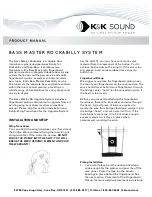
QuantAsylum QA401 User
’s
Manual
Page
9
with the same differential voltage. That is, the differential input of the ADC is seeing 0.5Vrms on each
input in both cases.
Rear Panel Summary
The rear panel has a single USB connector. This is designed for high speed (480Mbps) USB connections.
The device consumes between 500 and 600 mA during normal operation. The device is not sensitive to
USB voltage variations.
Note that newer computers may employ very strict current sensing on the USB power flowing out of the
USB port. When the current exceeds a bit over 500 mA, the PC hardware might signal a fault.
If you suspect your PC has strict limits on the power, then you can use a USB Y connector. These are
connectors that plug into 2 USB ports and allow USB hardware to pull up to 1000 mA. One of the USB
ports has no data connection. It just takes power from the second port.
Alternately, most low-cost USB hubs that are self-powered do no sensing or limiting at all.
Electrical Characteristics of the Connectors
BNC Inputs
The 4 inputs pass through a 33uF series capacitor, followed a series 100 ohm resistor, and followed by a
resistor divider with a total impedance of 100K ohms. The corner frequency of this input network is
about 1.6 Hz.
The input DC blocking capacitor is polarized, with a 50V rating. The DC blocking capacitor can withstand
a negative voltage of 15%, or 7.5V, for 125 hours. In general, we recommend you limit the long-term DC
level (relative to ground) to just a few volts, keeping in mind that the capacitor will degrade over time
depending on the magnitude of the voltage.
The input stage will be clamped to the internal input rails (about +/-6.5V) through the 100 ohm input
resistor. The input attenuator is very fast. We’ve tested overload conditions of 70Vpp for hours on end,
with no impact noted to the performance of the device. During overload, the system will detect the
excessive input and engage the attenuator. After 1 second, the attenuator will be released, and the
input level again checked. This cycle will repeat indefinitely. Of course, the audible indication of the
relay clicking every second should alert you that the input voltage is too large and to manually engage
the attenuator.
IF YOU GOING TO APPLY A HIGH DC BIAS TO THE QA401 INPUTS, YOU MUST MAKE ABSOLUTELY SURE
THE ATTENUATOR IS ENGAGED. SEE THE SECTION ON MEASURING POWER SUPPLY NOISE COVERED IN
RMS MEASUREMENTS.
DO NOT EXCEED THE RATED MAX INPUT VOLTAGE OF THE Q401. IT CAN RESULT IN PERMANENT
DAMAGE TO THE QA401.










































